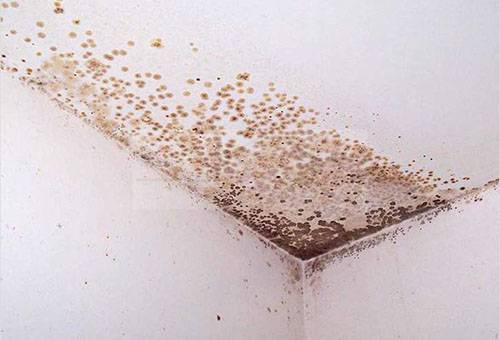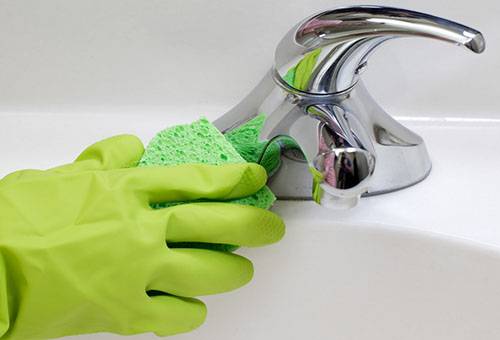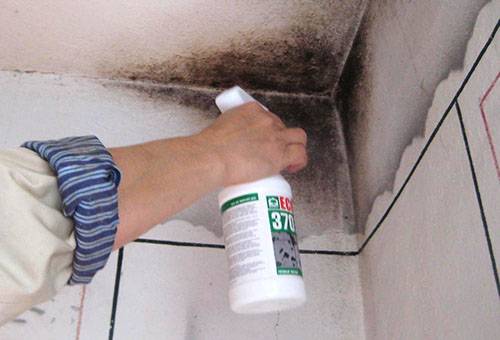How to get rid of mold on the ceiling and walls of the bathroom?
Knowing how to remove mold from the ceiling and other parts of the room will be useful for any person. After all, probably every housewife has encountered the appearance of this fungus at home, settling in damp places, especially in the bathroom and kitchen.

How dangerous is the fungus and why does it appear?
Mold is a very tenacious organism. It actively spreads microscopic spores around itself, and even when it seems that it has finally been gotten rid of, these spores are waiting for favorable conditions to begin to actively reproduce again.
Mold gradually eats away not only plaster and paint, but also even very strong concrete structures, as a result of which they gradually crumble, and in the worst case, they may collapse at some point. In addition to the fact that fungus spoils the appearance of the room and destroys some materials, it creates a musty smell in the room and can lead to lung infections and allergic reactions.
The main condition for mold to grow is dampness. Fungal spores are present almost everywhere, but in a dry room they do not multiply, and in a damp room a couple of weeks will be enough for an ugly black spot of fungus to spread across the wall, ceiling or furniture.
Obviously, the bathroom in any case remains the dampest place in the apartment, nothing can be done about it. But this is often aggravated by poor ventilation, leaking pipes, dripping taps and other additional sources of moisture.
Prevention measures
It is not enough to destroy a fungal colony once; it is important to create conditions for mold that are unfavorable for its reappearance.
- A heated towel rail helps dry the air in the bathroom. If a water dryer is not initially provided, you can install an electric one yourself and turn it on as needed.
- If one of the walls borders the staircase, then it should be additionally insulated to avoid constant condensation.
- All cracks and crevices in walls and ceilings must be sealed as soon as they are discovered to prevent water vapor and mold spores from accumulating there.
- It is also important to maintain all pipes and taps in good condition so as not to create excess moisture.
If all the plumbing in the apartment is in working order, the air is relatively dry, and there is still mold on the ceiling, then the problem may be a faulty pipe in the neighbors on the floor above.
Advice
To decorate a bathroom, you should use plasters and primers containing antiseptic additives, and purchase finishing materials designed for use in damp rooms.
How to fight fungus?
What to do if mold appears on the bathroom ceiling? In the most advanced cases, a radical remedy may be required - remove all furniture and equipment from there, remove coverings, and thoroughly dry the room with a powerful hair dryer. After this, it is necessary to apply antifungal agents. As a rule, they are quite harmful to the body, so work should be carried out in a protective suit. After the impregnation has completely dried, you can make repairs in the room.
But what to do if the bathroom renovation was done quite recently and you don’t want to repeat it at all? Is there any way to get rid of mold on the ceiling without harming the fresh finish? Yes, you can.
- Mold can be removed from smooth surfaces such as tiles with any detergent and a hard sponge. With porous surfaces, everything is more complicated, because the fungus penetrates deep into the structure of the material.
- Any chlorine-containing preparations are effective against fungus. This can be chlorine bleach (bleach, by popular name), powders like Comet, or special, very aggressive anti-mold agents like Dufa. But the chlorine compounds in these products are very harmful to the body, so it is better to work with gloves, protect your eyes with goggles, and your nose and mouth with a respirator or at least a thick cloth.
- Chlorine-free household chemicals are less harmful to humans and pets, but their effectiveness is significantly less, so they are mainly used as a preventive measure.
- Ammonia is considered a fairly effective remedy. It is diluted in approximately equal proportions with water, applied to the affected areas for several hours and washed off with water. However, in the hope of greater effectiveness, you should never mix ammonia with chlorine-containing products, since their reaction releases toxic substances.
- Vinegar is another good way to get rid of fungus in the bathroom, while being completely harmless to humans. Apply undiluted white vinegar to the affected area with a cloth or spray, leave for an hour or two, then wipe with a clean cloth and dry. Another safe but very effective remedy is borax (a weak salt of boric acid - sodium tetraborate).It is used in solution - 1 glass of dry product per 2-3 liters of water. Apply to the surface with a brush.
- Hydrogen peroxide, despite its completely harmless chemical composition, also helps get rid of mold quite well. Undiluted peroxide is applied to the surface in any convenient way. Since the product has a whitening effect, before using it on colored surfaces it is worth testing it in an inconspicuous place on the ceiling.
- A few tablespoons of baking soda (sometimes with vinegar added) dissolved in a glass of water is a safe way to remove fungus. The solution is applied with a spray; if necessary, the surface of the ceiling is rubbed with a brush or a stiff sponge, then all dirt is wiped off.
- A natural antiseptic that mold is very afraid of is tea tree oil. A few drops are dissolved in a cup of water and sprayed onto the affected area without rinsing. The product can fight not only the mold itself, but also the accompanying smell of dampness and mustiness. However, the oil should be used with caution if there are people with allergies in the house.
- Also a potentially allergenic, expensive, but very effective remedy is citrus seed extract (oranges, grapefruits, lemons).
If mold appears on seams sealed with sealant, it is better to remove it, treat the area, dry thoroughly, and then use a sealant with antifungal additives.

